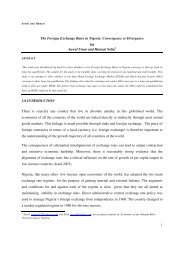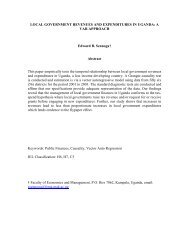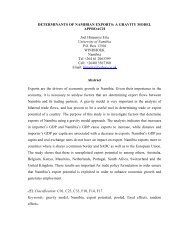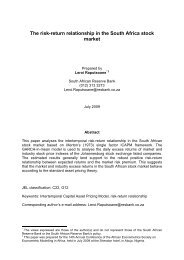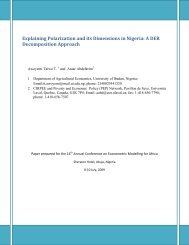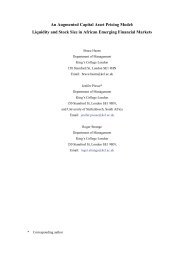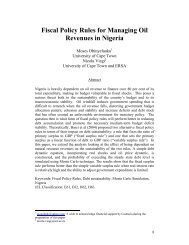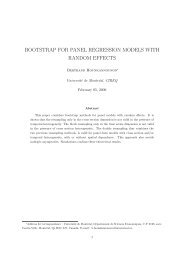Dynamic Effects of Monetary Policy Shocks in Malawi* - African ...
Dynamic Effects of Monetary Policy Shocks in Malawi* - African ...
Dynamic Effects of Monetary Policy Shocks in Malawi* - African ...
Create successful ePaper yourself
Turn your PDF publications into a flip-book with our unique Google optimized e-Paper software.
4.2.3. The Money Effect ModelAn alternative channel <strong>of</strong> monetary transmission is the monetarist view. The channel downplaysthe role <strong>of</strong> <strong>in</strong>terest rates and liquid asset adjustment <strong>in</strong> the transmission mechanism, reduc<strong>in</strong>g theprocess to a direct l<strong>in</strong>k between changes <strong>in</strong> aggregate money supply and absorption (Bolnick,1991). Accord<strong>in</strong>g to this view, prices and output respond to monetary impulses becausehouseholds and bus<strong>in</strong>esses fail to anticipate or perceive correctly all <strong>of</strong> the future implications <strong>of</strong>past and current actions (Meltzer, 1995). These misperceptions occur primarily because <strong>of</strong> theexistence <strong>of</strong> a time lag between observ<strong>in</strong>g the impulses and be<strong>in</strong>g able to dist<strong>in</strong>guish betweenpermanent and transitory impulses and real and nom<strong>in</strong>al shocks. A monetary shock, therefore,br<strong>in</strong>gs a wedge between money supply and money demand, which triggers adjustments <strong>in</strong>portfolio hold<strong>in</strong>gs that <strong>in</strong> turn alter spend<strong>in</strong>g decisions. We use aggregate money supply (M2) asan <strong>in</strong>dicator <strong>of</strong> the money effect. Append<strong>in</strong>g to the generic model, the vector <strong>of</strong> endogenousvariables <strong>in</strong> the money effect model is presented as:where the five variables <strong>in</strong> the model are output, consumer prices, M2, bank rate and reservemoney. Follow<strong>in</strong>g the identification scheme <strong>in</strong> system <strong>of</strong> equations (3.6), the model is identifiedas:(4.7)(4.8)Figure 4.9 presents impulse responses <strong>of</strong> M2 to own, bank rate and reserve money shocks andresponses <strong>of</strong> output and consumer prices to M2 shocks. A monetary tighten<strong>in</strong>g equivalent to a2.2 percent unexpected <strong>in</strong>crease <strong>in</strong> the bank rate leads to a significant <strong>in</strong>crease <strong>in</strong> M2. A reservemoney shock correspond<strong>in</strong>g to a sudden 7.2 percent <strong>in</strong>crease <strong>in</strong> reserve money, however, triggersno response <strong>in</strong> M2. A possible explanation for this occurrence is the dom<strong>in</strong>ance <strong>of</strong> commercialbanks <strong>in</strong> the trad<strong>in</strong>g <strong>of</strong> government securities. A sudden change <strong>in</strong> reserve money aris<strong>in</strong>g fromOMO transactions changes bank reserves proportionately without significantly affect<strong>in</strong>gcurrency and, term and demand deposits, except for the <strong>in</strong>terest component <strong>in</strong> matur<strong>in</strong>gsecurities. Accord<strong>in</strong>gly, aggregate money supply is <strong>in</strong>significantly affected by the reserve moneyshock.Both output and consumer prices respond significantly to unexpected changes <strong>in</strong> M2. Anunanticipated 6.1 percent <strong>in</strong>crease <strong>in</strong> M2 is followed by a rise <strong>in</strong> output, which peaks at 2.4percent above basel<strong>in</strong>e after 10 months and is significant up to 2 years. Consumer prices respondto the monetary expansion with an <strong>in</strong>itial price <strong>in</strong>crease, peak<strong>in</strong>g at 0.6 percent above basel<strong>in</strong>eafter 8 months. The response is significant up to five months.25 | P a g e



